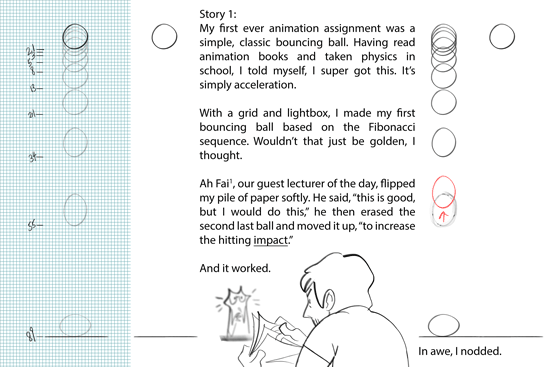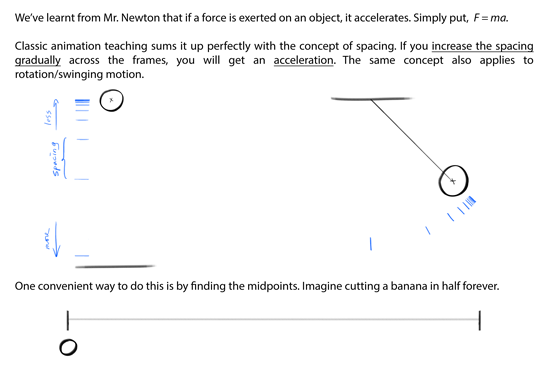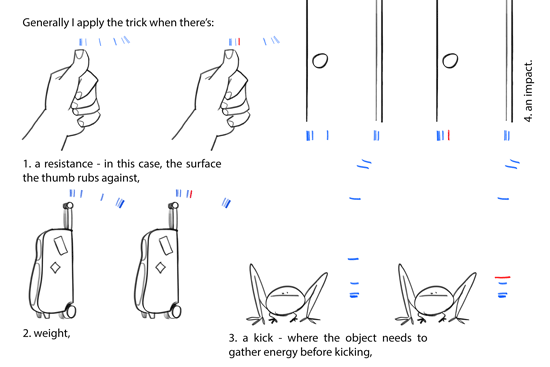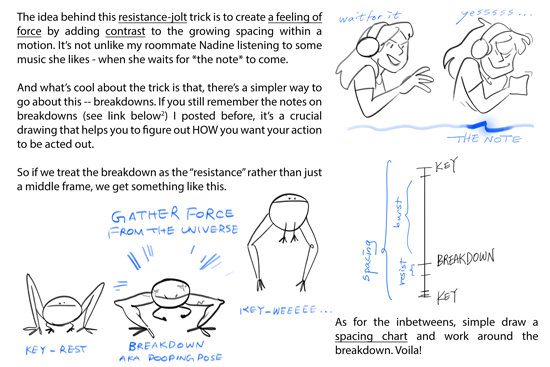I made this blog specially for me to gain as many resources to help myself to improve my animation
Don't wanna be here? Send us removal request.
Link
10 killer tips for better character animation
Monday, September 7th, 2015 | Article by Sébastien Wojda
vimeo
1. Record video reference right
After deciding how to stage your character to maximize appeal and clarity, record video reference of you or a colleague acting out the shot. Make sure the camera angle is the same as in your shot, so that you know if the silhouette of the character will read clearly, and act using clear gestures.
While you’re recording, think about original ways to perform the shot. Do a lot of different takes, choose a few of the best, and use them as guides to film yourself again. This usually helps to get a clearer performance.
When you’re satisfied, import the video reference into your shot and synchronize it with the dialogue or audio.

2. Prepare your shot properly
Once that you have planned your animation, think about the controllers you’re going to use. Place the character’s global control in a position that enables you to use as few controls as possible. It’s better to use only translate Z to get the character to go forwards than to need to use both translate X and translate Z.
It’s also better to get the follow on the head set up in World mode, so whenever the character rotates its body, the head stays in the same position. This avoids the need for counter animation. It’s the same with the arms: set them up in Local mode only for physical shots, when the character is going to move a lot.
Use IK only for contact poses: otherwise stay in FK mode. It might be faster to block out a movement with IK, but it’s painful to deal with the inbetweens later in order to get the result to look believable.
vimeo
3. Block out using step interpolation.
Based on your reference, block out your shot using step mode for interpolation (in Maya, Constant interpolation). Determine from your video reference which poses are key blocking poses, and try to place those keys on even-numbered frames so that it’s easier to add inbetweens and breakdowns later on.

4. Interpret the video reference: don’t just recreate it.
When posing the main keys, always remember which controls you used, and make sure that you always use the same ones so that you don’t end up with one control counter-animating another.Most of the time you’re going to have to exaggerate the poses to add more energy to your animation. Hide everything that could be distracting, like clothing, to really focus on the motion of the character’s body.
vimeo
5.Get the order right when switching to spline interpolation
When going from step to spline interpolation (in Maya, Bezier interpolation mode), always start with the body’s translate Y control (up/down) in order to get the weight right. This is the most important requirement for a good animation. If possible, hide the other parts of the character – the head, arms and legs – so that it’s easier to focus on the main movements, then keep working on the body using translate X and Z and rotations.When you get the body moving in a believable way, work on the head with just keep the head and body visible; then the arms; and finally the legs. Depending on the length of your shot, work in small chunks: for example, 24 frames at a time. It’s easier to focus on small portions of the animation, and it looks less overwhelming. Always keep a video of the step-interpolated version of your shot to compare with your spline-interpolated version, and try to keep the same energy in the animation.
vimeo
6. Use shark fin curves for facial animation
For facial animation, it’s sometimes good to use a type of curve called the ‘shark fin’, which helps to simulate rapid movements, like those of the eyebrows and lips.

If you look at the image above, you can see the movement starts quickly (1) before slowing down, creating a strong attack. This also works well with the eyelids. I also like to stop a movement before continuing it again, as you can see between points (2) and (3), so that the timing of the animation doesn’t look too even.Every part of the face moves really fast, especially the eyes, so try to get their movements to happen in one or two frames; three if the spacing is really big.
(Click on the link above to see the last four tips!)
366 notes
·
View notes
Photo






1. Ah Fai was a chief animator for McDull’s animated features. He’s super cool. Ultimate senpai.
2. Previous post on breakdowns right here
Some thoughts on acceleration and force
I presented this in the order of how I slowly understood the trick of delivering force - first an abstract concept of impact taught by Ah Fai, then a more complicated discovery on the acceleration pattern, last back to a more abstract concept of breakdowns.
Like I’ve previously stressed, 2D animation is everything but one single approach. There’s no one rule that rules them all, but interchangeable ideas with math, or physics, or music, etc. There’s no “perfect” animation either, but what is perceived as organic and dynamic. E.g., using the Fibonacci numbers to animate didn’t bring me a perfect animation! On the other hand, a tiny change in the pattern could already make the feeling of force so much more powerful.
Not so much of a tutorial than a personal experience. I hope you find this interesting hahaha
159K notes
·
View notes
Text
One day I want to be really good at animating. I don’t want to be the next anyone, not any next [insert names of great animation masters]. Just really good.
I want the characters or effects I animate be so alive that they inspire.
141 notes
·
View notes
Photo

Modelling Sealife - Eagle Ray
Hello, I’m Bryce, the environment artist at Giant Squid. I wanted to share a little bit about our art style and our process for creating the fascinating undersea life in ABZÛ. Let’s start with an eagle ray I did early in the project.
Our goal is to capture the essence of the creature and simplify the real life animal into a stylized version of itself. The first step is to analyze a lot of real life reference:

We try to pick out shapes that best represent the likeness of the creature and will do several quick drawings to determine the look and shape of the creature (pencil sketches here from our creative director Matt). If you look at a real eagle ray, you will notice there are a lot more curves and forms than our stylized version.

Next we make an untextured gray model. Looking at the wireframe here, you can see how we use hard edges on our models to give them a unique style and accentuate forms along the creature.
Then we create the texture, but we have to do a lot of simplification to make sure it stays within the style and can be recognized from far away. If we were to add all the real life detail to the texture the creatures would be visually noisy and hard for the player to identify.

Another trick we use when texturing is to actually cut into the geometry for certain designs or details. In some cases this is better than painting in the details to keep them crisp and clear and to avoid blurriness. On the eagle ray model you can see how I cut in the shape of the mouth and gills to get nice crisp hard lines.
You’ll be able to find the final eagle ray cruising around in the game, but if you can’t wait you can check out the 3d model right here on sketchfab.
sketchfab
Eagle Ray by bawarner8009 on Sketchfab
I hope you will enjoy discovering all wonderful wildlife in ABZÛ!
872 notes
·
View notes
Photo




Artists in Action!
Meet Brian Morante, one of the very talented storyboard artists on SpongeBob SquarePants! Brian has called Nick a creative home for many years, working as an artist on Monsters vs. Aliens and Breadwinners, and teaming with @nickanimatedshorts to create Earmouse and Bottle.
Read on to find out how he got started in animation and what inspires him to keep going!
——
1) What is your role here at NAS? How long have you worked here? I’m a storyboard artist on Spongebob SquarePants. I am going into my 6th year at Nick. I started out as a storyboard revisionist on Penguins of Madagascar.
2) How did you get started in Animation? I’m mostly self taught. I drew a ton, made my own animated shorts and comics, and collected a phat stack of rejection letters from animation studios all around town for years. Eventually my stuff was up to par and I applied to Nickelodeon. The timing and my talent finally matched up, and I got my first job.
3) What is your day-to-day like? Any interesting routines? I get in and I get a big cup of water and read the news (and the entire internet) to make sure the world still exists. And then I read through the script pages I want to get done for the day (I usually shoot for completing one page per day). I’ll sketch out little thumbnails on the script page and come up with gags or funny ways to play things out. Then I wring my hands about whether or not I’ll finish on time. Flesh out my thumbnails on the computer and hopefully make them funnier. Then wring my hands about whether anything I’ve done is good enough. Talk myself off the ledge and continue. And then there’s lunch with friends somewhere in there.
4) What continues to motivate you to be an artist and work in animation? It’s a demanding job but it is very fun. And it’s the only thing I’m actually good at. So short answer is: fun and homelessness.
5) What are the favorite parts of your job? I have the freedom to go off script and come up with my own gags or funny lines. I love creating that stuff. On a good day storyboarding feels like what it felt like to play with toys when you were a kid. Also, working around so many talented, funny people.
6) Tell us about a project or accomplishment that you consider to be the most significant in your career. A couple years ago I got the opportunity to make a short I pitched to the Nickelodeon Animated Shorts Program. It’s called Earmouse and Bottle. I learned a ton about the entire production pipeline, and got to work with a lot of talented people who helped create my vision. In the end I got this professionally made, finished product of a silly idea I came up with while doodling at home.
7) What/who inspires you? When I want to get the inspiration juices flowing I usually go to a book store or a comic book store. I walk around forever and look at EVERYTHING. Something about that gets me inspired to create.
8) What is your advice for aspiring artists or people interested in entering animation? Draw a lot. Draw everywhere and everything. Fill a sketchbook a month. Find friends that like to draw. Go out sketching with them at coffee shops, the mall, the zoo. Critique each other’s work. Attend life drawing classes/workshops. Look into what jobs there are in a studio. Pick one that plays to your strengths, and work towards that goal of creating a portfolio and then creating a better one. Look at work online from people that do those jobs. Recognize what it takes. Never settle for “good enough” in your work. There’s a line of people behind you who are working harder to become better than “good enough”. Then apply and apply again. Be ready for many rejection letters from many places. And then be ready to take it up a notch and try again. Ultimately your real goal is to become undeniably good. If you can do that, animation jobs will rain from the sky.
9) Who was your mentor? My freshman year in high school, my art teacher Nataha Lightfoot built his own animation equipment (light table, pencil tester, etc.). He started the animation club, which I joined immediately. The club turned into a class which I took every semester of high school. Mr. Lightfoot always encouraged me but mostly just helped by giving me access to everything I needed and left me alone to make all the crazy films I wanted. He went on to supply schools across the country with his animation supplies and teach other teachers how to teach animation. If you have an animation class at your school, chances are it’s because of him.
10) What are your favorite hobbies? I like to go out sketching with friends, and I love going to the movies.
11) What is one of the most challenging aspects of your job? Taking something that might be mildly entertaining or somewhat funny and pushing it to be something that is going to blow the roof off the place and make people laugh out loud. And doing it in very little time.
12) What is your spirit animal? Animal (from the Muppets). If I could make cartoons like Animal plays the drums… watch out!
13) Favorite Nickelodeon show? Ren and Stimpy.
14) Favorite Nickelodeon quote or catchphrase? “We’re not hitchhiking anymore… we’re riding” - Ren Hoek to bar of soap.
15) Favorite snack? This is a really boring answer, but trail mix can really get me through the day if my lunch wasn’t big enough. (If I didn’t care about my aging, bloating body I’d say candy.)
——
Follow Brian to see more of his amazing work:
Twitter: @brianmorante Tumblr: @brianmoranteart
And watch Brian’s Nick Animated Short Earmouse and Bottle.
1K notes
·
View notes
Text
writers:
break up your paragraphs. big paragraphs are scary, your readers will get scared
fuuuuck epithets. “the other man got up” “the taller woman sat down” “the blonde walked away” nahhh. call them by their names or rework the sentence. you can do so much better than this (exception: if the reader doesn’t know the character(s) you’re referring to yet, it’s a-okay to refer to them by an identifying trait)
blunette is not a thing
new speaker, new paragraph. please.
“said” is such a great word. use it. make sweet love to it. but don’t kill it
use “said” more than you use synonyms for it. that way the use of synonyms gets more exciting. getting a sudden description of how a character is saying something (screaming, mumbling, sighing) is more interesting that way.
if your summary says “I suck at summaries” or “story better than summary” you’re turning off the reader, my dude. your summary is supposed to be your hook. you gotta own it, just like you’re gonna own the story they’re about to read
follow long sentences w short ones and short ones w long ones. same goes for paragraphs
your writing is always better than you think it is. you just think it’s bad because the story’s always gonna be predicable to the one who’s writing it
i love u guys keep on trucking
226K notes
·
View notes
Photo





Some Show/Story Pitching tips for young creators.
20K notes
·
View notes
Photo


Layouts by the legendary animator Yoshinori Kanada (金田伊功) from Hayao Miyazaki’s 1988 classic My Neighbor Totoro (となりのトトロ) !
The cutest cat-bus and forest keeper, nefowls ! ^_^
12K notes
·
View notes
Photo





Animation Bible: Advanced Animation by Preston Blair
Let world-renowned animator Preston Blair introduce you to the magical world of cartooning and animation whether you're creating traditional or computer art, you'll find valuable information in this book!
These are some of the scans from the book that might help our understanding of the principles of animation.
Sure, this is only a tiny part of the book, you can order the book here to see much more animations tips!
66 notes
·
View notes
Video
youtube
Personal Favorite: The Alchemist’s Letter by Pixel Veil Production
Watch this beautifully animated CGI animated short film written and directed by the talented Carlos Andre Stevens!
Check out the original website here !
0 notes
Video
youtube
MUST WATCH: The Dam Keeper (Tonko House)
This Oscar nominated short animation is a wonderful creation from Tonko House, directed by former Pixar art directors Robert Kondo and Dice Tsutsumi.
This delicate artistry coupled with a lovely, touching narrative of loneliness and friendship makes a story worth watching.
Check out the original website here !
0 notes
Video
youtube
Free Rig: Malcolm 2.0
If you haven’t heard yet, AnimSchool released Malcolm 2.0!
It’s a free yet advanced rig from AnimSchool. Now,it is updated with much cooler outfits and hairstyles you can also animate!
Grab this awesome rig here
Happy animating, folks!
0 notes